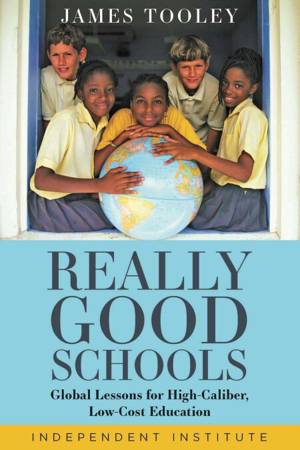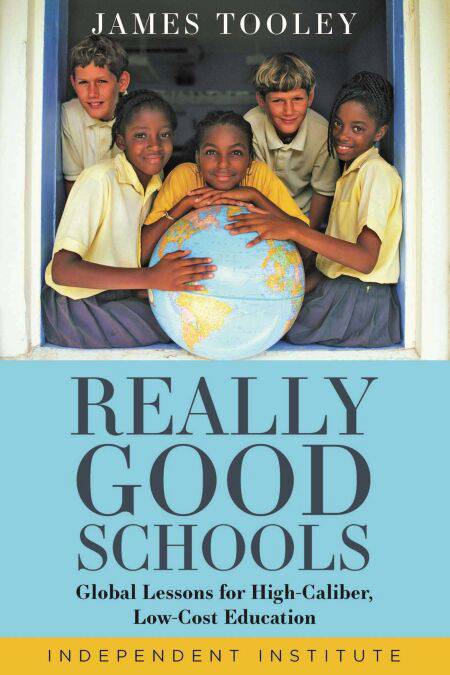
- Retrait gratuit dans votre magasin Club
- 7.000.000 titres dans notre catalogue
- Payer en toute sécurité
- Toujours un magasin près de chez vous
- Retrait gratuit dans votre magasin Club
- 7.000.0000 titres dans notre catalogue
- Payer en toute sécurité
- Toujours un magasin près de chez vous
Really Good Schools EBOOK
Global Lessons for High-Caliber, Low-Cost Education
James Tooley
Ebook | Anglais
16,76 €
+ 16 points
Format
Description
Almost overnight a virus has brought into question America’s nearly 200-year-old government-run K-12 school-system—and prompted an urgent search for alternatives. But where should we turn to find them?
Enter James Tooley’s Really Good Schools.
A distinguished scholar of education and the world’s foremost expert on private, low-cost innovative education, Tooley takes readers to some of the world’s most impoverished communities located in some of the world’s most dangerous places—including India and such war-torn countries as Sierra Leone, Liberia, and South Sudan. There, in places where education “experts” fear to tread, Tooley finds thriving private schools that government, multinational NGOs, and even international charity officials deny exist.
Why? Because the very existence of low-cost, high-quality private schools shatters the prevailing myth in the U.S., U.K., and western Europe that, absent government, affordable, high-quality schools for the poor could not exist.
But they do. And they are ubiquitous and in high demand. Founded by unheralded, local educational entrepreneurs, these schools are proving that self-organized education is not just possible but flourishing—often enrolling far more students than “free” government schools do at prices within reach of even the most impoverished families.
In the course of his analysis Tooley asks the key questions:
What proportion of poor children is served? How good are the private schools? What are the business models for these schools? And can they be replicated and improved?
The evidence is in. In poor urban and rural areas around the world, children in low-cost private schools outperform those in government schools. And the schools do so for a fraction of the per-pupil cost.
Ubiquity, affordability, quality, value for money, equity, choice, and sustainability—these are the seven categories by which schooling should be judged, according to Tooley. In every instance, one is forced to conclude that low-cost, non-governmental, entrepreneurial education, as practiced by the poor around the globe, contains the key to their rise to prosperity and leadership positions within their own respective cultures. Alarmed by recent government barriers in education, Americans can now find hope in the triumph—in the face of acute adversity—of these remarkable schools.
Because of the pandemic, parents in America and Europe are discovering that the education of their children is indeed possible—and likely far better—without government meddling with rigid seat-time mandates, outdated school calendars, absurd age-driven grade levels, and worse testing regimes. And having experienced the first-fruits of educational freedom, parents will be increasingly open to the possibilities of ever greater educational entrepreneurship and innovation. Thankfully, they have Really Good Schools to show the way.
Enter James Tooley’s Really Good Schools.
A distinguished scholar of education and the world’s foremost expert on private, low-cost innovative education, Tooley takes readers to some of the world’s most impoverished communities located in some of the world’s most dangerous places—including India and such war-torn countries as Sierra Leone, Liberia, and South Sudan. There, in places where education “experts” fear to tread, Tooley finds thriving private schools that government, multinational NGOs, and even international charity officials deny exist.
Why? Because the very existence of low-cost, high-quality private schools shatters the prevailing myth in the U.S., U.K., and western Europe that, absent government, affordable, high-quality schools for the poor could not exist.
But they do. And they are ubiquitous and in high demand. Founded by unheralded, local educational entrepreneurs, these schools are proving that self-organized education is not just possible but flourishing—often enrolling far more students than “free” government schools do at prices within reach of even the most impoverished families.
In the course of his analysis Tooley asks the key questions:
What proportion of poor children is served? How good are the private schools? What are the business models for these schools? And can they be replicated and improved?
The evidence is in. In poor urban and rural areas around the world, children in low-cost private schools outperform those in government schools. And the schools do so for a fraction of the per-pupil cost.
Ubiquity, affordability, quality, value for money, equity, choice, and sustainability—these are the seven categories by which schooling should be judged, according to Tooley. In every instance, one is forced to conclude that low-cost, non-governmental, entrepreneurial education, as practiced by the poor around the globe, contains the key to their rise to prosperity and leadership positions within their own respective cultures. Alarmed by recent government barriers in education, Americans can now find hope in the triumph—in the face of acute adversity—of these remarkable schools.
Because of the pandemic, parents in America and Europe are discovering that the education of their children is indeed possible—and likely far better—without government meddling with rigid seat-time mandates, outdated school calendars, absurd age-driven grade levels, and worse testing regimes. And having experienced the first-fruits of educational freedom, parents will be increasingly open to the possibilities of ever greater educational entrepreneurship and innovation. Thankfully, they have Really Good Schools to show the way.
Spécifications
Parties prenantes
- Auteur(s) :
- Editeur:
Contenu
- Nombre de pages :
- 432
- Langue:
- Anglais
Caractéristiques
- EAN:
- 9781598133400
- Date de parution :
- 11-04-21
- Format:
- Ebook
- Protection digitale:
- Adobe DRM
- Format numérique:
- ePub

Les avis
Nous publions uniquement les avis qui respectent les conditions requises. Consultez nos conditions pour les avis.






